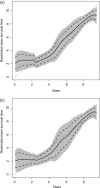Predicting the restricted mean event time with the subject's baseline covariates in survival analysis
- PMID: 24292992
- PMCID: PMC3944973
- DOI: 10.1093/biostatistics/kxt050
Predicting the restricted mean event time with the subject's baseline covariates in survival analysis
Abstract
For designing, monitoring, and analyzing a longitudinal study with an event time as the outcome variable, the restricted mean event time (RMET) is an easily interpretable, clinically meaningful summary of the survival function in the presence of censoring. The RMET is the average of all potential event times measured up to a time point τ and can be estimated consistently by the area under the Kaplan-Meier curve over $[0, \tau ]$. In this paper, we study a class of regression models, which directly relates the RMET to its "baseline" covariates for predicting the future subjects' RMETs. Since the standard Cox and the accelerated failure time models can also be used for estimating such RMETs, we utilize a cross-validation procedure to select the "best" among all the working models considered in the model building and evaluation process. Lastly, we draw inferences for the predicted RMETs to assess the performance of the final selected model using an independent data set or a "hold-out" sample from the original data set. All the proposals are illustrated with the data from the an HIV clinical trial conducted by the AIDS Clinical Trials Group and the primary biliary cirrhosis study conducted by the Mayo Clinic.
Keywords: Accelerated failure time model; Cox model; Cross-validation; Hold-out sample; Personalized medicine; Perturbation-resampling method.
Figures




Similar articles
-
Impact of censoring on learning Bayesian networks in survival modelling.Artif Intell Med. 2009 Nov;47(3):199-217. doi: 10.1016/j.artmed.2009.08.001. Epub 2009 Oct 14. Artif Intell Med. 2009. PMID: 19833488
-
Application of the Mayo primary biliary cirrhosis survival model to Mayo liver transplant patients.Mayo Clin Proc. 1989 Jun;64(6):699-704. doi: 10.1016/s0025-6196(12)65350-6. Mayo Clin Proc. 1989. PMID: 2664365
-
Primary biliary cirrhosis: prediction of short-term survival based on repeated patient visits.Hepatology. 1994 Jul;20(1 Pt 1):126-34. doi: 10.1016/0270-9139(94)90144-9. Hepatology. 1994. PMID: 8020881
-
Historical controls and modern survival analysis.Lifetime Data Anal. 1995;1(1):19-25. doi: 10.1007/BF00985254. Lifetime Data Anal. 1995. PMID: 9385088 Review.
-
A Tutorial on Evaluating the Time-Varying Discrimination Accuracy of Survival Models Used in Dynamic Decision Making.Med Decis Making. 2018 Nov;38(8):904-916. doi: 10.1177/0272989X18801312. Epub 2018 Oct 14. Med Decis Making. 2018. PMID: 30319014 Free PMC article. Review.
Cited by
-
Beyond hazard ratios: appropriate statistical methods for quantifying the clinical effectiveness of immune-oncology therapies - the example of the Netherlands.BMC Med Res Methodol. 2024 Oct 30;24(1):260. doi: 10.1186/s12874-024-02373-5. BMC Med Res Methodol. 2024. PMID: 39478443 Free PMC article.
-
Comparison between asymptotic and re-randomisation tests under non-proportional hazards in a randomised controlled trial using the minimisation method.BMC Med Res Methodol. 2024 Jul 30;24(1):166. doi: 10.1186/s12874-024-02295-2. BMC Med Res Methodol. 2024. PMID: 39080523 Free PMC article.
-
Regression models for average hazard.Biometrics. 2024 Mar 27;80(2):ujae037. doi: 10.1093/biomtc/ujae037. Biometrics. 2024. PMID: 38771658
-
Selection of the optimal personalized treatment from multiple treatments with right-censored multivariate outcome measures.J Appl Stat. 2023 Jan 10;51(5):891-912. doi: 10.1080/02664763.2022.2164759. eCollection 2024. J Appl Stat. 2023. PMID: 38524800 Free PMC article.
-
Where you live matters: Area deprivation predicts poor survival and liver transplant waitlisting.Am J Transplant. 2024 May;24(5):803-817. doi: 10.1016/j.ajt.2024.02.009. Epub 2024 Feb 10. Am J Transplant. 2024. PMID: 38346498
References
-
- Andersen P. K., Hansen M. G., Klein J. P. Regression analysis of restricted mean survival time based on pseudo-observations. Lifetime Data Analysis. 2004;10(4):335–350. - PubMed
-
- Chen P. Y., Tsiatis A. A. Causal inference on the difference of the restricted mean lifetime between two groups. Biometrics. 2001;57(4):1030–1038. - PubMed
-
- Cox D. R. Regression models and life-tables (with discussion) Journal of the Royal Statistical Society, Series B. 1972;34:187–220.
-
- Dabrowska D. M. Non-parametric regression with censored survival time data. Scandinavian Journal of Statistics. 1987;14(3):181–197.
Publication types
MeSH terms
Grants and funding
LinkOut - more resources
Full Text Sources
Other Literature Sources

